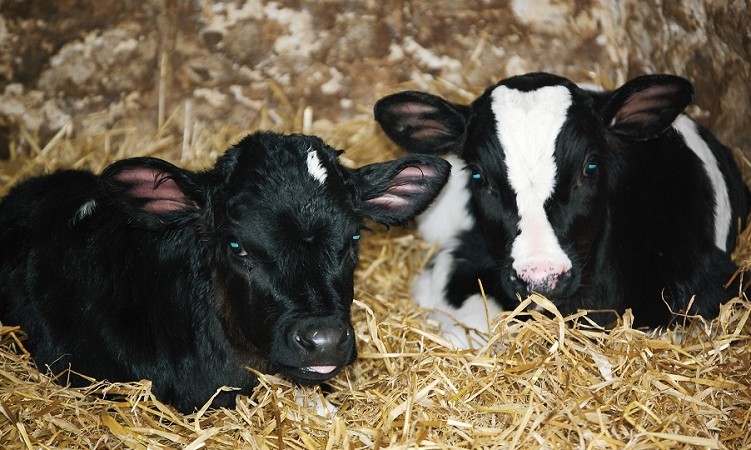

A calf is your future cow. If well fed it will grow into a healthy cow that will give you a good income. It is very important for a cattle farmer to consider three key issues to raise the desired number of productive future members of their herd. These key issues are; keeping calf mortality to a low level, maintaining good calf growth and maintaining good calf health.
Feeding of the calf
Feeding management should be directed at addressing nutrient requirements and encouraging rumen development. It is important to develop a feeding program with the aim of switching young calves to alternative feeds as early as possible so that more milk can be available for sale. However, the diet must be able to promote health and growth.
Calf Feeding Programs
Feeding during first week: At birth, the calf has low immunity and therefore must be given colostrum. The colostrums has antibodies that protect the calf against diseases and their absorption is highest within 12 hours after birth and very low after 24 hours. Calves should be allowed to suckle colostrum from their mothers. If the mother dies at calving or is unable to produce milk due to some condition, artificial or frozen colostrum can be used. Artificial colostrum can also be a good source of nutrients for a new born calf, an example composition of artificial colostrum: one egg (protein source) + half litre fresh warm water + half litre whole milk (source of lactose and milk protein) + one teaspoonful castor oil (energy) + one teaspoonful of cod liver oil (energy).
Feeding during 2nd week to one month:
Calves should be fed milk at approximately 10% of their body weight and should be fed at body temperature. Commercial milk replacers can be fed at this stage if they are available and are cheap as they would result in increased profits to the farmer and increase milk for human consumption. The milk replacer should contain 22% protein (if all protein is from milk sources) or 24% when some plant protein is included. The calf should be introduced to high quality pre-starters at this time.
Colostrum feeding can be summarised by the following 3 steps Preserved colostrums: High yielding cows may produce more colostrum than the calf can consume which can be preserved and fed later. The colostrum can be preserved by several methods. The most ideal is freezing but this may not be possible in small-scale farms without electricity supply. In such cases, the colostrum may be preserved through natural fermentation (storing at room temperature). Before feeding the preserved colostrum, it should be mixed with warm water at the ratio of 2 parts colostrum to 1 part water.
Milk replacers: These are commercial products manufactured to resemble milk and are mostly used when there is no milk to feed the calf if the cow is sick or if it has died during calving. They are also used when demand and price of milk is high. Preserved colostrums should be used as much as possible before a farmer decides to use milk replacer. Milk replacers are always of lower quality than whole milk and should only be fed if they are cheaper.
Pre-starter
A pre-starter is a high quality calf feed, which should be low in fibre and is almost similar to milk replacer and is usually fed during the second and third week. It is fed in a dry pelleted form or as a meal. It should be used early to stimulate calves to eat dry feed to enhance rumen development. Rumen development takes three weeks after the calf starts eating a handful of dry feed.
Calf starter:
The starter contains slightly higher fibre content compared with the pre-starter. At this stage the calf is consuming little milk and is in transition to becoming a ruminant.
Roughage:
Calves should be offered only high quality forages early in life and supplemented with concentrates (calf starter). If hay is used, it should be of high quality, fine texture and mixed with legumes. If they are on pasture, it would be best to always graze calves ahead of adults to control parasites. Some of the common roughages offered to calves are sweet potato vines and freshly harvested and wilted Lucerne.
Water:
Calves should be offered fresh water in addition to milk. Lack of drinking water slows down digestion and development of the rumen, and hence the longer it takes before calves can be safely weaned. Between three weeks and weaning, calves’ water consumption usually increases and should be available all the time. This programme should result in growth rate of approximately 400-500 grams per day.
Weaning
Weaning is the withdrawal of milk or milk replacer and the calf becomes fully dependant on other feeds. Traditionally, most dairy calves are weaned based on age, 12 weeks being the most common. Early weaning is possible if more milk is fed and calves introduced to pre-starter and starter early in life. To minimize stress, weaning should be done gradually. The twice a day milk feeding should be reduced to once a day then to once every other day to allow the calf’s digestive system to adjust to the new diet. Criteria that have been used to determine weaning time include when calf attains twice the birth weight, when the calf can consume 1.5% of its body weight of dry feed and age of calf. Early weaning (5 to 8 weeks) may be adopted to reduce the milk feeding period and labour required for calf rearing. This will require a specific feeding program using low levels of milk and high energy, high protein concentrates, preferably pelleted to stimulate rumen development. Liquid milk or milk replacer is reduced from 3 weeks of age to encourage the calf to consume and maximize intake of dry feeds. With proper management, the calf can live a healthy, fertile life and provide a high lifetime yield.
 Contact Jaguza Support
Contact Jaguza Support